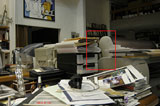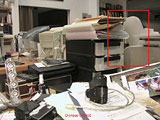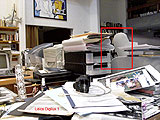
| Back to MAGAZINE |
Digital
Corner
|

|
The first thing I noticed when I picked up the camera in my hand, was that nice design, the controls all felt like being in the same place as those of an M6, there is definitely a family heritage to this model, with a solid ultra-light magnesium outer housing. There are plenty of things to like about this Digilux 1 camera, but also considerable issues to complain about. Let me start first with the good news. The camera is very light in weight, sturdy, very silent (like all Leicas) and it takes excellent sharp pictures in day light or when using flash. Set your camera to 100 ASA, and under those conditions you get a 4 million pixel file with very good quality, lets not forget it has a LEICA Vario-Summicron 1:2.0 -2.5/ 7-21 zoom lens. The viewing screen on the back is not only much larger in size than on any other camera I have seen in it's class, but the viewing quality is also very good. I found myself using the back screen rather than the view finder for shooting. This is very much a personal thing in how you choose to photograph, the pleasure of taking the picture and right away getting to look at how it came out is significant. Others just take the pictures like they would with a film based camera body through the viewfinder. I sometimes wonder if these habits will not change as the digital cameras offer us the possibility of observing the results, right away. I heard some photographers suggest that you might loose an important moment if you are looking at the back screen rather than through the view finder. An argument could be made just in reverse, that you miss out on having "the picture" being just right by not using the feedback offered by the digital back. In the end it's a matter of personal preferences, and what works out best for you. It's also important to point out that some cameras do not carry a live image through the rear screen, as does the Digilux from LEICA. in other words you don't get to see through the back screen what the camera sees before you shoot. The Nikon D100, is like that for instance, you can only see an image once it was recorded. |
|
|
These are distinctly different viewing strategies which we will have to see in time how they pan out. Some camera makers have done away all together, on some of their models, with the optical viewfinder, leaving only the rear digital screen for viewing. This obviously saves costs. In the Digilux you get a little hood to cover the rear screen, almost reminiscent of a view camera. It's a real pity however, that this camera does not have a swivel back like so many of it's competitors, the camera would be so much more interesting if it had this sort of a moving back, now so prevalent among other digital cameras. Let's go to some comparative test, you will find what we did with four digital cameras while I was sitting in front of my desk (excuse the mess!), hand held at night, with the lights that are normal to a room, at 400 ASA. These examples would be common to what a photographer might encounter under normal picture taking realities. You can look at the pictures in a comparative way if you click on the small image as then you will have floating window that allows you to make the needed comparisons. None of the images where worked on with any software, they are just as they came out of the camera. All the pictures were taken at the highest resolution the camera can make, and then reduced in size to accomodate the internet and viewing possibilities. The larger pictures show a red rectangle that makes reference to the area that which is not really enlarged, it is only at 100% of the original picture, which is why it looks enlarged, this is so you can take a view of the pixelation going on from one picture to the other, under the conditions of light mentioned before. The shots were taken at very low speeds and the lens as wide open as possible. The best results were with out a doubt produced by the D100 from Nikon, which only costs twice that of a LEICA, Digilux 1. But the advantages of the Nikon are so huge compared to all the other cameras, that they definitely favor the Nikon, D 100. What surprised me most, were the results by the Olympus C4040Z camera, notwithstanding that it costs much less than the LEICA camera, not only was the picture quality higher with a comparable size file (4.1 million pixels vs, 3.9 million for the LEICA), it also beat hands down the Canon G2, which up to now had been considered a very good option. Clearly now, the quality of the Canon G2 picture is not up to par, to that what their competition can achieve. We have to always remind ourselves that the speed at which changes take place among camera manufacturers, makes for a very short shelf life in the case of comparisons such as these. |
| Nikon D100 | Olympus C4040Z | Leica Digilux 1 |
Canon G2 |
 |
 |
 |
 |
 |
 |
|
This LEICA camera is not at it's best in low light conditions as you can appreciate here, at a higher ASA rating than 100, the level of "noise" is surprisingly high, for a camera with the LEICA label on it's body. We would have expected a lot better results under low light conditions, something so fundamental to photojournalism. We found for instance, as we wrote earlier, that the Olympus C4040Z which is considerably less expensive, does an overall better job, both in the quality of the image, as well as the size of file which is also a bit larger ( 4.1 million pixels vs. 3.9 million for the LEICA), it also has a brighter lens, albeit a small difference, f1.8 vs 2.0 for the LEICA, but when it comes to low level light, it does matter. In contrast the Olympus does not have a hot shoe for an external flash, and the design of the digital interface is down right cheese compared to the elegance of the LEICA user interface. The Digilux 1, left me very unhappy with their memory card, an SD (Secure Digital) memory card which comes with the camera, it's a 64 meg. Offered as a separate purchase item you can only go up to 128 meg (of course you can buy several cards, but added up it's quite a bit more expensive than other solutions), if you compare that with the one gigabyte Microdrive that other cameras can handle and you most definitely have a problem with the downloading of pictures at higher resolution, if you go out on a long shooting day. I hope they will adopt for future models, the new cards that are being produced by Olympus and Fuji, which will go to 8 gigabytes. Other issues come into play here, as the LEICA electronics are being produced for LEICA by Panasonic, these are all, in one way or another, either competitors or allies, and therefore such realities tend to collide with the best interest of the consumer. At the time the first cameras were available, one could not buy extra batteries for this camera. What surprised me very much is that the battery is identical both in shape and power supply to the one used on the Canon G2, yet they made some extra notches on the LEICA battery so that it could not be used interchangeably, I find this to be a very short sighted strategy. Obviously LEICA wants to sell the batteries of their camera, but if that is the only aspect that is considered, and not the users benefit then they will find themselves narrowed down in their potential, rather than enhanced. If there is only one battery that can be used, and the dealer does not have one in stock at that time, then you might not want to buy the camera at all, as who wants to go out with a camera that only has a single battery. No serious photographer would like to take such risks. However, what is interesting is that on the side of the cable connections, from the camera to the USB on your computer, the LEICA uses a different approach, the same cable that works for the Nikon D 100 is the one that works on the LEICA. That I find something to be thankful, as I do not need to connect and disconnect cables every time I use a different camera. There ought to be a lot more interchangeability on matters such as cables, batteries and battery chargers. It truly does not make sense that everyone has a different piece of equipment. In going over the manual I found on page 152, a bit of very interesting information. Under setting the picture properties. It reads: " One of the many advantages of electronic photography over traditional photography is that is is very easy to change critical properties" and it goes on with an elaborate description. The part that I found so striking is that a traditional company such as LEITZ the makers of the LEICA camera and lenses, recognize in their own manual, that there are many advantages to digital photography over what they themselves now call "traditional" photography. Clearly the message has finally arrived, and I can just imagine the internal debates among the traditionalists within LEICA, and those who want to embrace the future. The debates about the design of this their first digital camera that is commercially available, where probably influenced strongly not only by these internal debates at Leitz, GMBH , but also by the designers at Panasonic, as well. It will be interesting to keep track of what happens now over the coming years as new models are brought to market, and we can see a clear evolutionary process, to this bastion of photography. Let us not forget Oskar Barnack the designer of the first precision miniature camera to become available commercially, the LEICA I, which was introduced in 1924 by the Ernst Leitz optical firm at Wetzlar, Ger. Barnack was a master mechanic and inventor who joined the Leitz optical firm in 1911. Barnack had completed a prototype of the LEICA by 1913, but World War I and the postwar chaos in Germany delayed production. The success of the LEICA I promoted the use of 35-millimetre and other small cameras. Barnack determined the standard 24 x 36-millimetre picture size for 35-millimetre film and was partly responsible for designing the Leitz Elmar lens. Let us hope that this leadership will once again come to bear on the design of cameras in the digital age. So far the Digilux 1, is no LEICA 1 camera. We just will have to wait for future designs to prove if they really made the transition from a machine shop to an electronic one. Pedro Meyer Some late breaking news which can put some added dimension to some of the comments we have made earlier here and elsewhere, about the race of the megapixels at various price levels. PIXEL BARRIER BREAKTHROUGH: Sinar announces a large-format, rectangular color sensor developed exclusively for its program with a resolution of more than 22 million pixels. Sinar is the only company that has a large-format sensor with a resolution of 22,195,200 pixels. Thanks to the large sensor surface, optimal use is made of the image circle and lens resolving power. It is also ideal for medium format cameras. Kodak also announced several new digital camera models at Photokina. The EasyShare LS443 is a high-end consumer model with resolution of 4 megapixels, a high-quality Schneider-Kreuznach 3x zoom lens and an enhanced LCD screen that allows photos to be viewed clearly even in bright sunlight. The camera is set to go on sale next month for $500. Kodak also announced the DCS Pro 14n, a professional SLR digital camera with resolution of 14 megapixels, the highest yet offered in professional-level digital cameras. The camera will cost about $4,000 when it goes on sale in December. Also pushing the megapixel envelope is Canon, which unveiled the EOS-1Ds, an 11-megapixel professional SLR that will sell for around $9,000 when it begins shipping in November. |